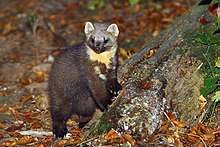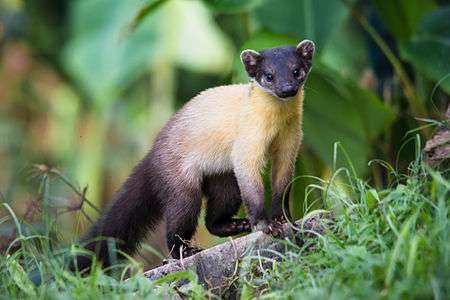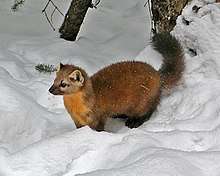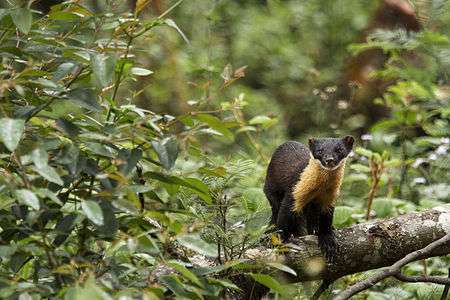Marten
The martens constitute the genus Martes within the subfamily Guloninae, in the family Mustelidae. They have bushy tails and large paws with partially retractile claws. The fur varies from yellowish to dark brown, depending on the species, and is valued by trappers for the fur trade. Martens are slender, agile animals, adapted to living in the taiga, and inhabit coniferous and northern deciduous forests across the Northern Hemisphere.
| Marten | |
|---|---|
 | |
| European pine marten (Martes martes) | |
| Scientific classification | |
| Kingdom: | Animalia |
| Phylum: | Chordata |
| Class: | Mammalia |
| Order: | Carnivora |
| Family: | Mustelidae |
| Subfamily: | Guloninae |
| Genus: | Martes Pinel, 1792 |
| Type species | |
| Martes foina | |
| Species | |
|
See text | |
 | |
Marten ranges:
| |
Classification

Results of DNA research indicate that the genus Martes is paraphyletic, with some studies placing Martes americana outside the genus and allying it with Eira and Gulo, to form a new New World clade.[1][2] The genus first evolved up to seven million years ago during the Miocene epoch.
| Image | Scientific name | Common Name | Distribution |
|---|---|---|---|
 | Martes americana | American marten | arctic Alaska and Canada to northern New Mexico. |
 | Martes flavigula | Yellow-throated marten | Afghanistan and Pakistan, in the Himalayas of India, Nepal and Bhutan, the Korean Peninsula, southern China, Taiwan and eastern Russia. |
 | Martes foina | Beech marten | Spain and Portugal in the west, through Central and Southern Europe, the Middle East and Central Asia, extending as far east as the Altai and Tien Shan mountains and northwest China |
 | Martes gwatkinsii | Nilgiri marten | southern India. |
| Martes martes | European pine marten | Europe and SW Asia, from Ireland in the west, eastward to the Urals and into Anatolia, Transcaucasia, Mesopotamia and northern Iran. | |
 | Martes melampus | Japanese marten | Japan |
 | Martes zibellina | Sable | eastern Kazakhstan, China, North Korea and Hokkaidō, Japan |
Fossils
- Martes wenzensis†
- Martes nobilis†
Etymology
The Modern English "marten" comes from the Middle English 'Mearth' or martryn in turn borrowed from the Anglo-French martrine and Old French martre (Latin martes), itself from a Germanic source; cf. Old English mearþ, Old Norse mörðr, and Old High German and Yiddish מאַרדאַר mardar. A group of martens is called a "richness."[3]
Ecology and behaviour
Martens are solitary animals, meeting only to breed in late spring or early summer. Litters of up to five blind and nearly hairless kits are born in early spring. They are weaned after around two months, and leave the mother to fend for themselves at about three to four months of age. Due to their habit of seeking warm and dry places and to gnaw on soft materials, martens cause damage to soft plastic and rubber parts in cars and other parked vehicles, annually costing millions of euros in Central Europe alone, thus leading to the offering of marten-damage insurance, "marten-proofing", and electronic repellent devices.[4][5][6][7] They are omnivorous.
Cultural references
Canada
The marten is popular in the northern Ontario community of Big Trout Lake. During the fur trade, commissioned by the Hudson Bay Company in the 17th and 18th centuries, the marten pelt was typically fashioned into mittens. The marten is still traded locally. The locals place a high value on this pelt, typically trading it for consumable goods.
Croatia
In the Middle Ages, marten pelts were highly valued goods used as a form of payment in Slavonia, the Croatian Littoral, and Dalmatia. The banovac, a coin struck and used between 1235 and 1384, included the image of a marten. This is one of the reasons why the Croatian word for marten, kuna, is the name of the modern Croatian currency.[8] A marten is depicted on the obverse of the 1-, 2-, and 5-kuna coins, minted since 1993, and on the reverse of the 25-kuna commemorative coins.[9]
A running marten is shown on the coat of arms of Slavonia and subsequently on the modern design of the coat of arms of Croatia. The official seal of the Croatian Sabor (parliament) from 1497 until the late 18th century had a similar design.[10][11]
Finland
The Finnish communications company Nokia derives its name, via the river Nokianvirta, from a type of marten locally known as the nokia.[12]
Italy
The Latin word for helmet, galea, originally meant "marten pelt," although it is unclear whether early Romans wore these helmets for symbolical reasons or for their fine fur.[13]
References
- Flynn JJ, Finarelli JA, Zehr S, Hsu J, Nedbal MA (2005). "Molecular phylogeny of the carnivora (mammalia): assessing the impact of increased sampling on resolving enigmatic relationships". Syst. Biol. 54 (2): 317–37. doi:10.1080/10635150590923326. JSTOR 20061233. PMID 16012099.
- Koepfli KP; et al. (Feb 2008). "Multigene phylogeny of the Mustelidae: resolving relationships, tempo and biogeographic history of a mammalian adaptive radiation". BMC Biology. 6 (10). doi:10.1186/1741-7007-6-10. PMC 2276185. PMID 18275614.
- Lipton, James (1991). An Exaltation of Larks. Viking. ISBN 978-0-670-30044-0.
- "Marderinfo" [Information about martens] (in German). Retrieved 15 September 2014.
- "Marderschaden - Tipps gegen Marder" [Marten injuries - Tips against martens] (in German). Retrieved 15 September 2014.
- "Tipps gegen Marder" [Tips against martens] (in German). Retrieved 15 September 2014.
- "Marderschäden am Auto – wie ist das versichert?" [Car damage caused by martens—is that a part of insurance?] (in German). Retrieved 15 September 2014.
- Croatian National Bank. First Money — History of the Croatian Currency Archived 2011-06-22 at the Wayback Machine: Kuna and lipa — the Croatian Currency. – Retrieved on 31 March 2009.
- Croatian National Bank. Kuna and Lipa, Coins of Croatia Archived 2009-06-22 at the Wayback Machine: 1 Kuna Coin Archived 2009-06-22 at the Wayback Machine, 2 Kuna Coin Archived 2011-06-04 at the Wayback Machine, 5 Kuna Coin Archived 2011-06-04 at the Wayback Machine, & Commemorative 25 Kuna Coins in Circulation Archived 2018-02-01 at the Wayback Machine. – Retrieved on 31 March 2009.
- Mario Jareb (2010). Hrvatski nacionalni simboli (Eng.: Croatian National Symbols). ISBN 9789532972306.
- Ivan Bojničić-Kninski - Grbovnica kraljevine "Slavonije", (1895) - PDF file (in Croatian)
- Story of Nokia, retrieved on the 17 July 2013
- Speidel, Michael P. (2008). Ancient Germanic warriors : warrior styles from Trajan's Column to Icelandic sagas. Routledge. ISBN 9780415486828. OCLC 632066572.